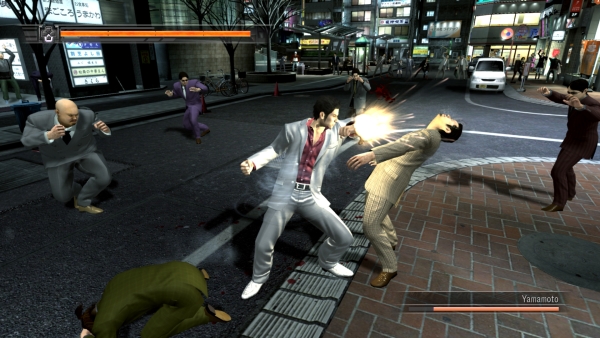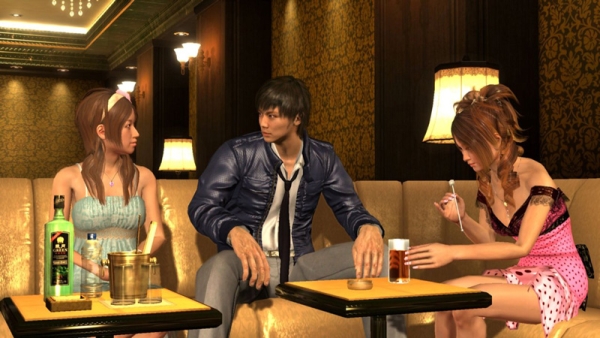
The Yakuza franchise has always struggled for respect in the West. Despite being extremely popular in its native Japan, none of the games have made much of a dent outside its borders – but at the same time the series has built a small, dedicated following. After the painful “will it or won’t it” with Yakuza 3, Sega made sure to avoid the same situation by quickly confirming that, yes, Yakuza 4 was getting localized.
Though it still requires a modicum of knowledge in the lore of Yakuza, this fourth entry is, in many ways, a re-introduction to the characters and universe. While the game doesn’t have any revolutionary changes to the formula – not a surprise considering there have been four releases in five years – some of the design choices make Yakuza 4 seem like a new starting point for future entries in the series. As long as you’re not completely worn out by the familiar formula, this is another great entry into a seriously underappreciated franchise.
Platforms: PS3
Publisher: Sega
Developer: Sega
Genre: Tokyo Red Light District Virtual Vacation
Release Date: March 15, 2011
ESRB Rating: Mature
Despite being a lesser known franchise, Yakuza 4 is still a risky entry in the series given the passionate audience. Rather than focus on traditional series protagonist Kazuma Kiryu, Y4 introduces three other playable characters alongside the Dragon of Dojima. You begin the game playing as Shun Akiyama, a “loan shark” who seems only interested in lending money to people who otherwise cannot get financing. He’s not your typical loan shark, however, as he never demands collateral and instead offers potential clients a “test” to check their character. If they pass, they get the money, no questions asked.
Later, you meet up with Taiga Saejima, a brute of a man who has been imprisoned for twenty-five years following a messy 1985 hit on a Tojo Clan rival – a hit that becomes the cornerstone of the plot in Yakuza 4. Moving on, your next new friend is Masayoshi Tanimura, a young detective dubbed “the parasite of Kamurocho” due to his tendency to demand bribes from some of the seedier businesses in the neighborhood.
Of course, Kazuma is playable too, but he doesn’t really appear on the scene until the final quarter of the game. While all these characters have separate lives that don’t seem to interact, their adventures intertwine as you progress through yet another Yakuza-related mystery. In this case, the infamous 1985 hit is the focal point, as the planning, execution, and confusing details draw all our playable characters together in the present. Without spoiling too much, Yakuza 4’s plot carries on the traditions of the franchise – betrayal, greed, misdirection, and a ton of intrigue. When a quiet, shy woman wanders into a loan office looking for billions of yen, and is willing to work as a Hostess to prove her worthiness, you know something crazy is going on.

Like previous entries in the series, Yakuza 4 offers a “reminisce” mode that lets you catch up on older games in the series – a wise choice given the complexity of the overall story arc. They don’t make up for playing the other three games, however… so perhaps check them out before coming back here. They’re some of the very best PS2 and PS3 games.
Trying to shoehorn the Yakuza games into a genre is tough. It’s kind of an open-world game, but because Kamurocho is a small location compared to traditional sandbox games, it barely counts. Instead, it’s more of an RPG brawler, as the game features “random” battles from various punks standing around, experience points for engaging in said battles, and a heaping helping of side-quests to amuse you between story missions. Due to the inclusion of four playable characters, quests and experience are segregated from everyone else – experience and “substories” stay with one of the playables and nobody else can access it. Y4 even divvies up the Hostess girls to the point where only one specific character can “date” a certain lady. To help this out, when you reach the end of the story, it’s possible to switch between all four characters to wrap up any business you missed out on during their portion of the story.
As one might expect, each playable character plays quite differently. Akiyama, for instance, is all feet – almost every single move in his repertoire is a kick. He’s also fast and agile, especially compared to the lumbering Saejima. In truth, I really didn’t like playing as Saejima – he’s slow, plodding, and cumbersome. It was almost liberating when Tanimura came around, as he’s something of a combination of both Kiryu and Akiyama. Speaking of, Kazuma plays basically the same as Yakuza 3 – which is to be expected, given his reduced role in Yakuza 4.
As mentioned before, everyone levels up independently, and they all have their own “skill tree” with unique moves. They also have their own specific “revelation” events. Fans of Yakuza 3 likely remember these bizarre happenings that ultimately lead to the discovery of unique moves, and they’ve returned for the sequel. These events range from a restaurant owner beating the daylights out of a dine-and-dasher, a scorned wife getting her payback from her “experimental” husband, and even better, a female detective using her feminine wiles – albeit without her involvement – to subdue a kidnapping suspect. It’s all very amusing, which is a hallmark of the series: a serious plot countered by downright crazy happenings while exploring.

Though Yakuza 4 is still a solid game, it’s definitely starting to show its age. The first issue is the full-time return to Kamurocho, something that hasn’t been the case since the original game. While the addition of rooftop and underground areas adds a ton of new spots to explore, you still spend much of the game wandering around the same city that’s been used for years now. Without an Osaka or Okinawa to explore this time around, the familiar setting can be a bit… suffocating, I guess. The combat, which has always been solid, is also beginning to show signs of wear. The general mechanics haven’t changed at all, and it’s never exactly been perfect – it’s still way too easy to punch at air with the awkward targeting. The series also remains a bit light on challenge – seeing the game over screen almost takes effort on the default difficulty. Still, the game delivers a lengthy quest with tons and tons of diversions, from wasting time with UFO machines, to eating lots of food, to hanging out at the homeless casino (really), to romancing the numerous Hostesses in the clubs, which have made a welcome return after being cut from Yakuza 3.
Yakuza 4 hasn’t really received much of a visual upgrade either. There are some great rainy day effects, but they rarely pop up, and otherwise you’re left with the same engine as Yakuza 3. That means you’re going to get weird character models that are beefed up and constantly out of breath, alongside repetitive design for NPCs and opponents. It’s not bad, mind you, but considering the game uses the same basic engine as the original Yakuza game, it’s definitely aging. This is one of those times, however, that the massive amount of content evens out any visual issues, and hey, it doesn’t have framerate issues or any other technological problems.
Like Yakuza 2 and Yakuza 3, Yakuza 4 uses Japanese voices with English subtitles. Some might balk at this, of course, since it means constant reading of cutscenes instead of just listening, but it fits the whole “gangsters in Tokyo” motif. But with the Japanese voices, you know you’ll get some quality acting, and more importantly, familiar characters use the same talent as before, so they’re familiar voices even in a foreign language. The music is the Yakuza standard – dramatic pieces for story scenes, balanced by crazy J-rock and J-pop for battles. The included Karaoke songs are pretty awesome too. One thing I miss (or just don’t notice anymore) is the recording of crowd noise – in the PS2 games, one could always hear the buzz of people talking around you.
Recommending Yakuza 4 goes a little something like this: if you’re a fan, this is a must-buy game. The series is starting to age a bit, and some time off is definitely needed to recharge some batteries over at Sega, but what’s here is still high quality gaming. It’s lengthy, it’s unique, and it’s mature in its storytelling, making it a rare game that doesn’t use blood and guts to tell its sordid tales of life in organized crime. Without getting too hyperbolic, the Yakuza series can almost be considered The Godfather of games… though Yakuza 4 is dangerously close to being The Godfather Part III of the series. It’s still great, but we’re reaching overkill status and that would be a shame. This series is just too good to be run into the ground so quickly.

Review Disclosure: A retail copy of Yakuza 4 was purchased by Warp Zoned for the purposes of this review.







